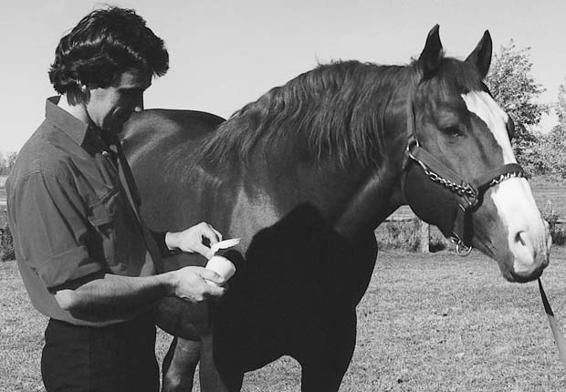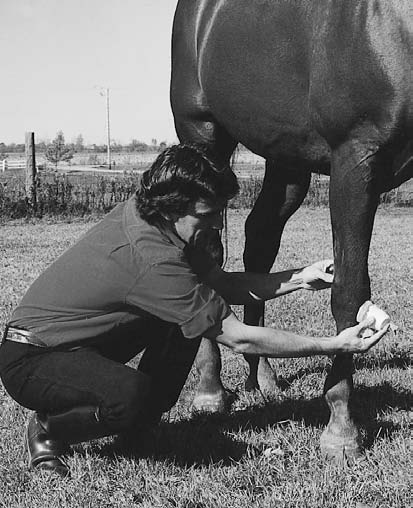Equine Massage: A Practical Guide (19 page)
Read Equine Massage: A Practical Guide Online
Authors: Jean-Pierre Hourdebaigt

❖ Petrissage with firm kneadings, compressions, wringing, picking-up moves, and skin rolling
❖ Coarse vibrations
❖ Coarse shaking
❖ Frictions, fine and coarse
❖ Nerve manipulation with nerve pressure, nerve friction, and nerve stretching
❖ Tapotements with clapping, cupping, hacking, beating, and pounding
Pure Nervous Reflex Movements
Pure nervous reflex massage movements result in a lessening of nervous tension, stress and anxiety, and promote strong relaxation.
The pure nervous reflex moves are:
❖ Stroking
❖ Fine vibrations
❖ Nerve stroking
❖ Laying on of hands
Regular practice of massage on your horse will quickly develop
your ability to know the approach necessary for each type of massage.You will be amazed at how much information you can learn
through your fingertips, and this will give you confidence.
Remember, practice makes perfect. And even more, quality practice
makes perfect.
4
HYDROTHERAPY
In this book, the term
hydrotherapy
is used to mean water treatment applied externally to the horse’s body. If used before and after massage, hydrotherapy will increase the effectiveness of massage treatment.
Hydrotherapy comes in a number of forms, depending on the temperature of the water, the method of application, the duration of treatment, and so on.
Water applications can produce both a temporary and a longer-lasting effect. For example, cold water first constricts the blood vessels and numbs the nerve endings; then it triggers a longer-lasting dilation of the vessels. Hot water first dilates the blood vessels and soothes the nerve endings; then it causes a longer-lasting relaxation of the tissues.
The following chart classifies water by temperature.
Water Temperature
Cold
40 to 60°F (4.4 to 15.5° C)
Cool
65 to 75°F (18.3 to 23.8°C)
Tepid
85 to 95°F (29.4 to 35°C)
Warm
90 to 100°F (32.2 to 37.7°C)
Hot
100 to 110°F (37.7 to 43.3°C)
WARNING: For hot applications, the temperature should be 41 to 53.6°F ( 5
to 12°C) above normal body temperature, which is about 100.4°F (38°C).
Between 109.4 and 122°F (43 to 50°C) should be safe.
Above 122°F (50°C),
you risk burning the skin.
Use a thermometer to be sure.
Heat and cold are used to relieve pain in acute or chronic conditions and in inflammatory disorders in both humans and animals. Heat and cold are peerless as methods that are effective, safe, easy to apply, free from side effects, and cost-effective.
87
88
Equine Massage
Duration of Treatment
The more extreme the temperature, the shorter the duration of the application. The more moderate the temperature, the more prolonged the application.
Because they affect the cutaneous nerve endings, both heat and cold decrease pain and muscle tension. They do this through opposite physical effects and therefore are used at different stages of an injury’s development.
Length of Duration
Actual Time
short duration
15 to 60 seconds for initial application of heat or cold, especially on
sensitive areas
average duration
prolonged duration
3 to 10 minutes for warm and cold
applications
very prolonged
10 to 30 minutes for tepid or cool
duration
applications and poultices
Stages of Recovery
Typically in therapy, there are three stages in the recovery process of an injury: acute, subacute, and chronic.These definitions are not exact; there are in-between stages as well.
The Acute Stage
The first 24 hours following an injury is the acute stage. Use cold immediately. This will stop hemorrhaging in the damaged tissues and will contribute to reducing any swelling before you commence treatment. You can apply cold as ice (in solid form or crushed with some water in a plastic bag) or as cold running water. After you have performed your massage (swelling technique, chapter 5) you should apply more cold.
The Subacute Stage
Between 24 and 72 hours after an injury is the subacute stage. By then the injury has usually stabilized. Use the
vascular flush,
which is the alternation of cold and hot applications for several minutes each. Right after massage, you might apply some cold to soothe tender tissues.
Hydrotherapy
89
The In-Between Stages
When closer to the acute condition (first 24 to 48 hours), first apply cold for 3 minutes, then apply hot for 2 minutes. Repeat this cycle 3 times, up to 4 or 5 times per day.
Always finish with cold
for 2 minutes.
Follow with a light effleurage toward the heart or simply use stroking if the body part appears too sensitive.
When closer to the chronic stage (48 to 72 hours), first apply hot for 3 minutes, then apply cold for 2 minutes. Repeat 3 times, up to 4 or 5 times per day.
Always finish with cold for 2 minutes.
Follow with a light effleurage toward the heart or use light stroking if the body part appears too sensitive.
The Chronic Stage
Beyond 72 hours is the chronic stage. Use heat to loosen the tissues and to increase blood circulation. After massage, you might apply some cold to soothe the tender tissues, especially if you have worked deeply.
When an old chronic injury flares up, soreness with some degree of inflammation and swelling might occur at the site. In this case, use cold hydrotherapy to relieve the edema and numb the irritated nerve endings.This action will take the inflammation down and allow you to work more easily.You might use a vascular flush as well, finishing with cold for 2 minutes.Consider the situation carefully. If you choose to use cold water over a large area (for example, to deal with inflammation of the back), do not apply it if the horse is cold or chilled.Warm up the animal first by walking or longeing him. However, if a cold water treatment is to be used over a local area (for example, in the case of tendonitis), the warming up of that area can simply be achieved by massage (wringings and effleurages).
Cold
Cold is widely used in emergencies right after trauma to stop any bleeding and to prevent excessive swelling. Cold can also be applied during the flare-up of old chronic injuries to reduce inflammation and pain.
Effects of Cold
Cold water application first chills the skin, which causes constriction of the capillaries. This constriction drives the blood to the interior of the body, thus reducing circulation and preventing swelling in the trauma area. Cold also decreases pain by numbing the sensory nerve endings.

90
Equine Massage
After the cold is withdrawn, there comes a secondary reaction.
The capillaries expand, allowing blood to return to the body’s surface. This reaction is the body’s defense mechanism to warm the entire body. If the treatment is applied to the entire body, circulation will be stimulated all over as well.
This stimulation will raise the body’s temperature and blood pressure, contract muscles, strengthen heart action, stimulate the nervous system, stimulate the metabolism, and slow and deepen breathing.
Prolonged cool applications produce effects similar to cold, but these are not as marked and the reaction is therefore less pronounced.
Application of Cold
Cold is used most often in the acute stage, immediately following trauma or surgery. Ice packs and other cold applications may be used for contusions and sprains during the first 24 hours. Cold reduces hemorrhaging and swelling in the damaged fibers. It also contributes to controlling pain by activating the production of endorphins.
In treating acute problems be careful not to lower the body temperature too much by excessive cold or prolonged water treatment.
A “cold reaction” might follow. Gently stimulate circulation with some effleurages, wringings, shakings, or light friction massage.
4.1 Ice Massage Technique:
Peeling the rim of the foam or paper cup for the
ice massage application.
Hydrotherapy
91
Cold is also used in chronic cases to decrease pain in very tender sores or to reduce swelling in a chronically inflamed area (caused by tendonitis, bursitis, or arthritis). By absorbing heat from the irritated area, cold lowers the metabolic rate, thereby keeping the inflammation down. It also reduces the incidence of muscle spasms and reduces nerve irritation by slowing down the velocity of nerve conduction. All of this breaks the pain-spasm-pain cycle.
Cold is used extensively in the control of inflamed tendons and joint structures.
Cold water should be used to relieve pain from burns.
Immediately immerse the burned area in very cold or ice water, or spray cold water over the area until the animal is pain-free.
Check with your veterinarian if the burn is serious.
Cold Devices and Techniques
Several cooling devices are used in cold therapy:
❖ Specially designed, Velcro-equipped leg wraps containing chemical ice bags.These leg wraps are easy to assemble and are very convenient to use when traveling.
❖ Specially designed leg boots that can be filled with cold water.
❖ The most widely known, and very practical, application is cold water hosing (spraying or bathing).
❖ Buckets of cold water are very practical and popular for horses to stand in when treating the lower leg. To remove toxins from the skin and keep swellings down, some people add cider vinegar and sea salt to the water.You can also consider sponging the upper aspect of the leg if necessary.
❖ Crushed ice and water in a towel-wrapped plastic bag applied to the skin and held with a bandage is both practical and inexpensive.
❖ Poultices are very effective in relieving tendon inflammation.They are semisolid mixtures of clay in cotton cloth that are applied cold to the body part.
❖ A cotton towel wrung out in cold water and kept in a refrig-erator or freezer can be wrapped around a leg or joint to fight inflammation. Hold it in place with a leg wrap or pin.
❖ A cold towel or cold mitten applied with large friction movements over the whole body will produce a stimulating, tonic effect.
❖ Sponging with cool water is a quick way to cool off a horse during exercise.
❖ Some facilities are equipped with pools for water exercises, but these are not always easy to access.

92
Equine Massage
4.2 Ice Massage Technique:
Applied here on
the knee.
The Ice Cup Massage
Take a 4 to 8 ounce paper or foam cup, fill it with water and freeze it. Hold the cup by the bottom, peel the rim away and, using circular motions, apply the ice to massage the coat. The rhythm should not be too slow or too fast: approximately 4 seconds per 5-inch circle. The pressure should be light (1 or 2
pounds).The application should last for 2 to 5 minutes maximum.
Observe the structure, the degree of swelling, and the inflammation present in, and tenderness of, the tissues. Be careful not to cause ice burns. Follow with a light massage (strokings, effleurages, gentle kneadings) or wrap the area with some cloth to generate warmth quickly.This technique is very useful when dealing with any swelling and inflammation.
Duration of Cold Application
Cold used in an emergency (acute stage) should be applied for a prolonged (3 to 10 minutes) to a very prolonged (10 to 30 minutes) duration, depending on the size and nature of the injury.
Cold used in chronic cases should be applied for a prolonged duration (3 to 10 minutes) and up to 15 minutes, according to the size of the swelling.
Hydrotherapy
93
Direct application of ice, such as an ice massage, should be of prolonged duration (3 to 10 minutes).
When using cold on an open, bleeding wound, do not apply it for more than 10 to 15 minutes because it will interfere with coagulation.
